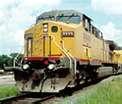
Rail Crashworthiness, Maintenance Worker Rules Nearly Done
The Federal Railroad Administration's Rail Safety Advisory Committee will meet June 25 in Washington, D.C., with several of its projects about to reach the proposed or final rule stage, FRA said in a new update.
The Federal Railroad Administration's Rail Safety Advisory Committee is scheduled to meet June 25 in Washington, D.C., as several of its projects near fruition, according to an FRA update published June 19 in the Federal Register. One of these is a final rule, now with a target publication date of June 25, on front-end strength of cab cars and multiple-unit locomotives for crashworthiness. The agency has completed its reworking of the text in response to comments received in 2007.
Another project is a Vehicle/Track Interaction Task Force's proposed revisions to 49 CFR parts 213 and 238, principally regarding high-speed passenger service. The committee approved the task force's report in February 2008, and FRA is writing a Notice of Proposed Rulemaking that has a target publication date of September 2009.
The committee's work to increase the on-track safety of railroad employees and contractors engaged in maintenance work brought about a rule for adjacent track protection because of an increase in worker fatalities that occurred on adjacent track, but a draft NPRM in 2008 was quickly withdrawn out of concern it failed to accurately capture the consensus recommendations of the committee; now, FRA says it will publish a second adjacent track NPRM by Aug. 31, 2009, and a longer, comprehensive roadway worker safety rulemaking in late 2009.
Work continues by a Physicians Task Force on draft medical standards to be used by railroad Chief Medical Officers and railroad physicians to assess whether safety-critical employees, who have specific medical conditions and/or take certain medications are medically fit for duty. FRA said it is trying to provide a draft medical standards document by June 30, 2009.